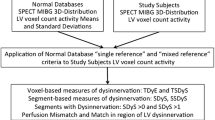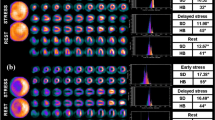Abstract
Iodine-123 metaiodobenzylguanidine (MIBG) uptake was reported to be reduced compared to Tl-201 (Tl) in acute myocardial infarction (AMI). Within such an area, degrees of both sympathetic neural function and ischemic myocardial cell damage are considered to be greatly dispersed. These kinds of damage were reported to effect reporalization time in myocardial cells, and we evaluated our hypothesis that extension of the discordant MIBG uptake area correlates with recovery time (RT) dispersion and relate ventricular arrhythmias in AMI. MIBG and Tl images were obtained in AMI patients. Regional Tl or MIBG uptake was estimated in 9 segments of SPECT by using four-point scoring. The total score was the sum of scores in 9 SPECT segments. ΔTl-MIBG was calculated by subtracting the total MIBG score from the total Tl score. Corrected RT (RTc) was measured as a signal-averaged ECG. RTc dispersion was defined as the difference between maximal and minimal RTc. The patients were assigned to two groups (group A; ≤Lown 4a, group B; ≥Lown 4b) according to the results of 24-hour Holter monitoring. A positive correlation between RTc dispersion and ΔTl-MIBG was found. ΔTl-MIBG and RTc dispersion in group B were greater than those in group A. These results suggested that ΔTl-MIBG could be used to predict the development of malignant ventricular arrhythmias.
Similar content being viewed by others
References
Marcus FI, Cobb LA, Edwards JE, Kuller L, Moss AJ, Bigger JT, et al. Mechanism of death and prevalence of myocardial ischemic symptoms in the terminal event after acute myocardial infarction.Am J Cardiol 1988; 61: 8–15.
Restivo M, Gough WB, EL-Sherif N. Ventricular arrhythmias in the subacute myocardial infarction period. High-resolution activation and refractory patterns of reentrant rhythms.Circ Res 1990; 66: 1310–1327.
Dorian P, Newman D, Hughes W, Langer A, Freeman M. Torsades de pointes ventricular tachycardia following right pneumonectomy: insights into the relation between right cardiac sympathetic nerve damage, QT intervals, and arrhythmias.Int J Cardiol 1994; 46: 292–296.
Glancy JM, Garratt CJ, Woods KL, de Bono DP. Use of lead adjustment formulas for QT dispersion after myocardial infarction.Br Heart J 1995; 74: 676–679.
Sporton SC, Taggart P, Sutton PM, Walker JM, Hardman SM. Acute ischaemia: a dynamic influence on QT dispersion.Lancet 1997; 349: 306–309.
Bogun F, Chan KK, Harvey M, Goyal R, Castellani M, Niebauer M, et al. QT dispersion in nonsustained ventricular tachycardia and coronary artery disease.Am J Cardiol 1996; 77: 256–259.
Lee KW, Okin PM, Kligfield P, Stein KM, Lerman BB. Precordial QT dispersion and inducible ventricular tachycardia.Am Heart J 1997; 134: 1005–1013.
Oikarinen L, Viitasalo M, Toivonen L. Dispersions of the QT interval in postmyocardial infarction patients presenting with ventricular tachycardia or with ventricular fibrillation.Am J Cardiol 1998; 81: 694–697.
Inoue H, Zipes DP. Results of sympathetic denervation in the canine heart: supersensitivity that may be arrhythmogenic.Circulation 1987; 75: 877–887.
Kuo CS, Reddy CP, Munakata K, Surawicz B. Mechanism of ventricular arrhythmias caused by increased dispersion of repolarization.Eur Heart J 1985; 6 (Suppl D): 63–70.
Opthof T, Coronel R, Vermeulen JT, Verberne HJ, van Capelle FJ, Janse MJ. Dispersion of refractoriness in normal and ischaemic canine ventricle: effects of sympathetic stimulation.Cardiovasc Res 1993; 27: 1954–1960.
Dae MW, O'Connell JW, Botvinick EH, Ahearn T, Yee E, Huberty JP, et al. Scintigraphic assessment of regional cardiac adrenergic innervation.Circulation 1989; 79: 634–644.
Shimizu W, Kamakura S, Ohe T, Kurita T, Takaki H, Aihara N, et al. Diagnostic value of recovery time measured by body surface mapping in patients with congenital long QT syndrome.Am J Cardiol 1994; 74: 780–785.
Jull-Moller S. Corrected QT-interval during one year follow-up after an acute myocardial infarction.Eur Heart J 1986; 7: 299–304.
Locati E, Schwartz PJ. Prognostic value of QT interval prolongation in post myocardial infarction patients.Eur Heart J 1987; 8 (Suppl A): 121–126.
Schwartz PJ, Wolf S. QT interval prolongation as predictor of sudden death in patients with myocardial infarction.Circulation 1978; 57: 1074–1077.
Ahnve S, Helmers C, Lundman T, Rehnqvist N, Sjögren A. QTc intervals in acute myocardial infarction: first-year prognostic implications.Clin Cardiol 1980; 3: 303–308.
Ahnve S, Gilpin E, Madsen EB, Froelicher V, Henning H, Ross J. Prognostic importance of QTc interval at discharge after acute myocardial infarction: a multicenter study of 865 patients.Am Heart J 1984; 108: 395–400.
Perkiomaki JS, Koistinen MJ, Yli Mayry S, Huikuri HV. Dispersion of QT interval in patients with and without susceptibility to ventricular tachyarrhythmias after previous myocardial infarction.J Am Coll Cardiol 1995; 26: 174–179.
Zabel M, Portnoy S, Franz MR. Electrocardiographic indexes of dispersion of ventricular repolarization: an isolated heart validation study.J Am Coll Cardiol 1995; 25: 746–752.
Sasaki R, Sugisawa K, Iwasaki T. Use of the body surface recovery time for detection of coronary artery disease.Jpn Heart J 1997; 38: 345–360.
Lekakis J, Antoniou A, Vassilopoulos N, Tsinikas D, Palaistides C, Kostamis P, et al. I-123 metaiodobenzylguanidine—thallium-201 mismatch following myocardial infarction.Clin Cardiol 1994; 17: 21–25.
Dae MW, Herre JM, O'Connell JW, Botvinick EH, Newman D, Munoz L. Scintigraphic assessment of sympathetic innervation after transmural versus nontransmural myocardial infarction.J Am Coll Cardiol 1991; 17: 1416–1423.
Mines GR. On circulating excitations in heart muscle and their possible relation to tachycardia and fibrillation.Trans R Soc Can 1914; 8: 43–52.
Spear JF, Michelson EL, Moore EN. Reduced space constant in slowly conducting regions of chronically infarcted canine myocardium.Circ Res 1983; 53: 176–185.
Spear JF, Michelson EL, Moore EN. Cellular electrophysiologic characteristics of chronically infarcted myocardium in dogs susceptible to sustained ventricular tachyarrhythmias.J Am Coll Cardiol 1983; 1: 1099–1110.
Dillon SM, Allessie MA, Ursell PC, Wit AL. Influences of anisotropic tissue structure on reentrant circuits in the epicardial border zone of subacute canine infarcts.Circ Res 1988; 63: 182–206.
Fu GS, Meissner A, Simon R. Repolarization dispersion and sudden cardiac death in patients with impaired left ventricular function.Eur Heart J 1997; 18: 281–289.
Dae MW, O'Connell JW, Botvinick EH, Chin MC. Acute and chronic effects of transient myocardial ischemia on sympathetic nerve activity, density, and norepinephrine content.Cardiovasc Res 1995; 30: 270–280.
Endoh Y, Kasanuki H, Ohnishi S, Shibata N, Hosoda S. Influence of early coronary reperfusion on QT interval dispersion after acute myocardial infarction.Pacing Clin Electrophysiol 1997; 20: 1646–1653.
Moreno FL, Villanueva T, Karagounis LA, Anderson JL. Reduction in QT interval dispersion by successful thrombolytic therapy in acute myocardial infarction. TEAM-2 Study Investigators.Circulation 1994; 90: 94–100.
Author information
Authors and Affiliations
Corresponding author
Rights and permissions
About this article
Cite this article
Masai, M., Naruse, H., Morita, M. et al. Discordant iodine-123 metaiodobenzylguanidine uptake area reflects recovery time dispersion in acute myocardial infarction. Ann Nucl Med 15, 357–363 (2001). https://doi.org/10.1007/BF02988243
Received:
Accepted:
Issue Date:
DOI: https://doi.org/10.1007/BF02988243




